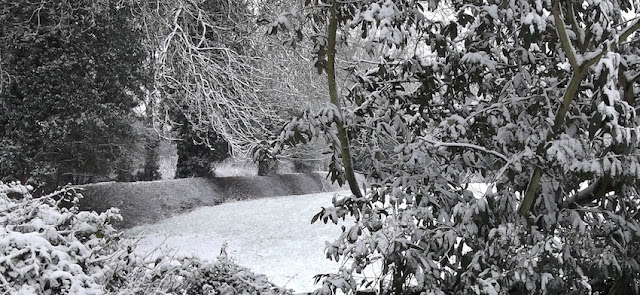Abstract Landscape Painter. Rural Dweller. Lover of Modernist Art and Design.
Time away
The days are definitely lengthening. It's great to get up at 6.15am and see light already in the sky and hear the robin singing. In fact, I'm sure that I heard his intermittent stirrings as early as 4.15am the other day! I'm really looking forward to the whole Spring dawn chorus starting again. It's such a brilliant time of year. It feels as if everything lies before you and everything is possible once again. I'm amazed how that hope is built into us as humans, and how we constantly rise to start again, even through very tough times.
This morning I went outside and fed the female pheasant that comes into our garden daily. Every year we get two or three that are regular visitors. The females are so trusting. After seeing me for only a few days they will run to me when I step outside the back door of the cottage. Today she even let me take her photo!
Progress on the poetry-inspired painting has been slow this week. My head has felt as foggy as the morning photo due to an encroaching cold and I've had a number of necessary appointments to attend and trips to make which have kept me out of the studio. I dislike not being able to really get into the flow of my work and unless I've produced something satisfying at the end of the day I don't feel as if I've really done anything. Life is so full of distractions and I understand that administration or hospital appointments are necessary, but unless I'm making a painting I don't feel as if I've done any "proper" work. I've often heard painters say that if they are not painting, then they are thinking about painting. This is definitely true of me. We are a little obsessive to say the least!
By Friday afternoon, however, I managed to finish it. Having a bit of time away may have helped in the end. A period of time away from a piece usually allows me to see it afresh, just for a few seconds, and therefore better determine what is needed. It has a similar effect to turning the painting upside down or looking at it in a a mirror. I couldn't work without a mirror. My brain gets so used to seeing it in one way and needs to be presented with it as something unfamiliar. In this way it can be jolted into working with it afresh.
I also had to sacrifice one particular area that I had been hanging onto. I've noticed that this is often the case. It is very difficult to do late on in a piece of work, and I therefore try not to become too attached to any one area early on, as everything has be constantly up for grabs if I am to make a successful whole. I had been hanging onto one key area all week, but as soon as I bit the bullet and painted over it with a broad sweep, the whole painting became more alive. The vitality of the brushwork showed and the composition began to hang together as one piece. I am continuing to try to produce simpler paintings, and to this end I find that removing areas in this way works well. There is the added bonus that the new, simpler, area is rich in character as it contains several previous layers underneath. All of this adds to the depth of colour and texture.
All text and images ©2013 Carol Saunderson









